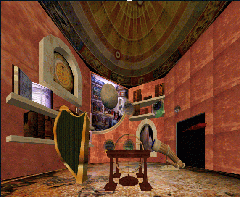The Virtual Mail System
September 1st, 1998 - May 15th, 2001
Categories: MS / PhD Thesis, Networking, Software, Tele-Immersion

About
Traditionally E-mail has been the most effective asynchronous collaboration tool available to us. The goal of V-mail is to provide an equally, if not more, effective asynchronous collaboration tool for Tele-Immersion (TI). In particular V-mail was designed to facilitate collaborations between participants that may be geographically located at distant parts of the world where timezone differences prevent routine synchronous collaboration. When recording a V-mail message both audio and gesture from the collaborator are captured in addition to the surrounding scenery. When the message is played back, the avatar of the original sender of the message materializes to re-enact the message. After viewing the message the viewer may reply as in a standard e-mail system.
By recording speech, gesture and the surrounding scenery, collaborators are able to create richer messages than those traditionally possible via standard e-mail or voice mail. Participants are able to see the sender’s avatar naturally gesturing while describing an observation in the VE. This is particularly effective when the concept being described has an intrinsicly spatial quality.
Early implementation of a prototype of this system has led us to expand the application of this technology to also include the use of this recording system for training in TI. In this situation pre-recorded sequences may be scripted and played at appropriate moments that are triggered by user responses.
Traditionally E-mail has been the most effective asynchronous collaboration tool available to us. The goal of V-mail is to provide an equally, if not more, effective asynchronous collaboration tool for Tele-Immersion (TI). In particular V-mail was designed to facilitate collaborations between participants that may be geographically located at distant parts of the world where timezone differences prevent routine synchronous collaboration. When recording a V-mail message both audio and gesture from the collaborator are captured in addition to the surrounding scenery. When the message is played back, the avatar of the original sender of the message materializes to re-enact the message. After viewing the message the viewer may reply as in a standard e-mail system.
By recording speech, gesture and the surrounding scenery, collaborators are able to create richer messages than those traditionally possible via standard e-mail or voice mail. Participants are able to see the sender’s avatar naturally gesturing while describing an observation in the VE. This is particularly effective when the concept being described has an intrinsicly spatial quality.
Early implementation of a prototype of this system has led us to expand the application of this technology to also include the use of this recording system for training in TI. In this situation pre-recorded sequences may be scripted and played at appropriate moments that are triggered by user responses.